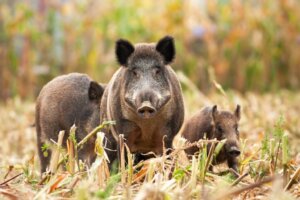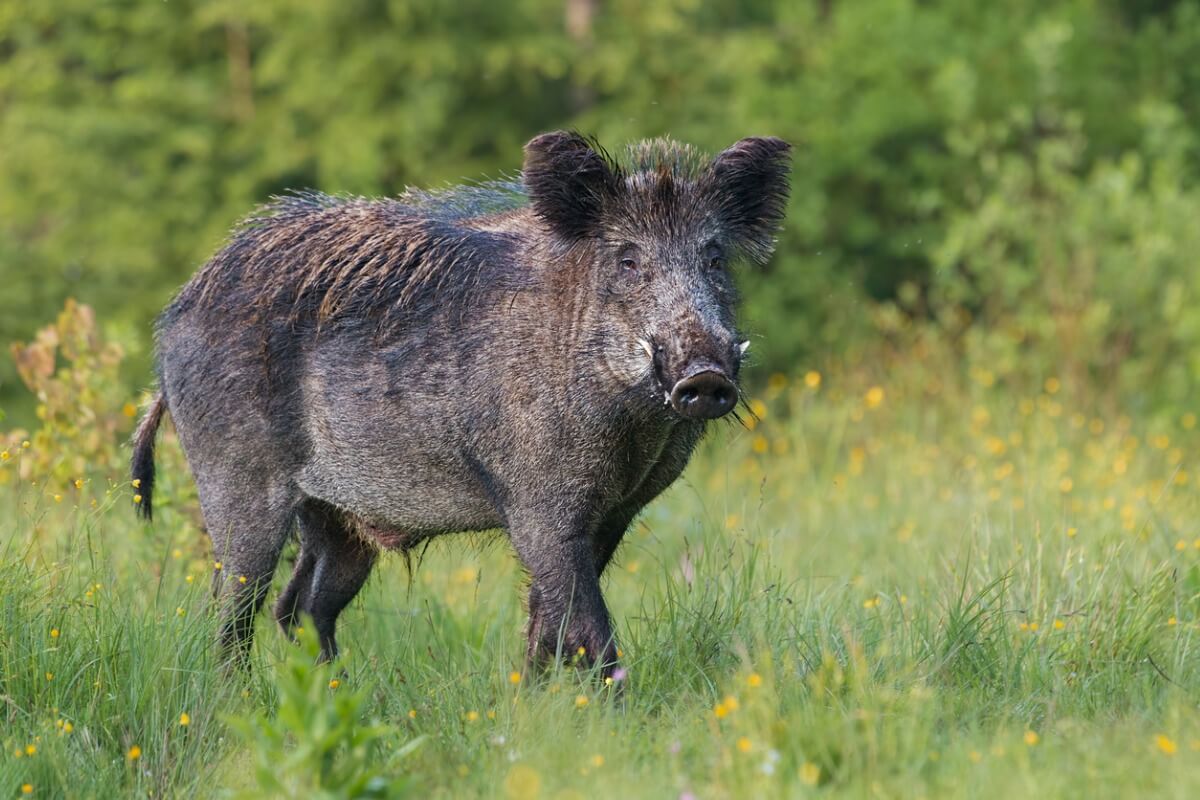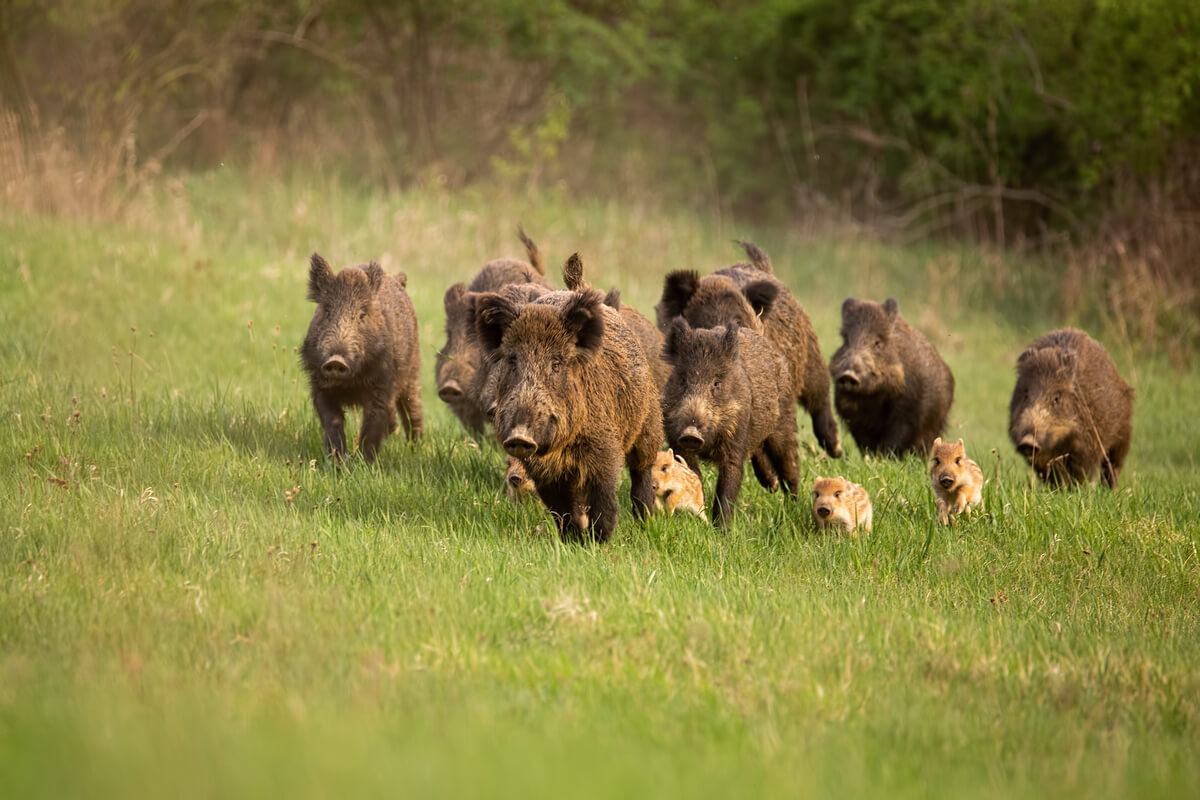11 Curiosities About Wild Boars


Written and verified by the biologist Georgelin Espinoza Medina
Boars are very popular animals all over the world. With their robust body, size, and tusks they can seem very intimidating. However, there are aspects of their biological makeup, behavior, and curiosities about wild boars that you may not know.
Their scientific name is Sus Scrofa and they’re included in the Suidae family along with other pigs, both wild and domestic. If you want to learn a little about them, you’ve come to the right place, as we’ll bring you 11 curiosities about wild boars that will fascinate you!
Curiosities about wild boars
Here, without further ado, we’ll get stuck into these fascinating curiosities about wild boars.
1. One of the most harmful invasive species in the world

These animals are also known as European or Eurasian wild boars, due to their place of origin, since they’re native to Europe, Asia, and certain regions of North Africa. However, they’re widely distributed worldwide, due to their introduction into other territories and their adaptive capacity.
These mammals are included in the IUCN list of the 100 most harmful invasive species in the world (IUCN). They have earned this title because they damage crops, properties, vegetation areas, and soil when they go in search of food. As they pass through, they leave the typical marks called sickle marks.
One of the reasons for the success of this species is that they know how to exploit resources very well, both from natural environments and from human food sources.
2. The coat varies according to age
One of the interesting curiosities of wild boars is their coloration. The young or wild boars have a coat with characteristic stripes, with brown or yellow tones, which serve to mimic them. These disappear at around 6 months of age.
When they’re between 6 months and 1 year old, their coat becomes reddish and brownish. After that time, it becomes darker and white hairs may appear on certain parts of the body, such as the head and flanks.
3. They have large upper tusks
Another evident aspect of a male boar, even with its mouth closed, is its upper tusks. These can measure between 5 to 10 centimeters (2 to 4 inches) in length, larger than the lower ones. In addition, they show constant growth throughout their lives.
4. Excellent sense of smell and hearing
The eyes of wild boars are small and not very developed. However, this is compensated by other senses, such as excellent smell and hearing capacities, which allows them to search for food and detect threats.
5. They emit a variety of sounds
These animals are gregarious, with highly developed vocal communication. They emit a variety of calls throughout their lives. One of the curiosities about wild boars is that when they’re young, this type of expression becomes relevant, as they develop up to 106 different sounds that are easily understood by the mother.
In adults, there’s also a variety of sounds, including grunts, squeaks, and different tones in between. The most frequent are short grunts, related to alert or high-pitched calls, with an escape function. In addition, vocalizations occur during the reproductive stage.
6. Wild boars are omnivorous animals
Among the curiosities about wild boars is their diet, and, despite their intimidating appearance, they prefer to consume plants. They especially like the fruits, roots, leaves, shoots, seeds, among other parts.
However, they’re not ruminants, so even though they opt for vegetables, they can’t assimilate more than 30% of the proteins in these products. Because of this, they need to supplement their diet with animal sources.
The animals that wild boars eat are varied, ranging from invertebrates (worms, insects, mollusks, crabs) and small vertebrates (including reptiles, amphibians, birds, and some eggs). People have observed them eating carrion too, which makes them animals with a broad trophic spectrum.
Wild boars know how to take very good advantage of the resources, whatever the season or ecosystem, so their feeding habits are more seasonal.
7. The reproductive cycle occurs in times of abundance
An amazing aspect about wild boars is that their reproductive cycle is related to the season with the greatest abundance of resources. In Mediterranean environments, it coincides with the acorn season, between the months of October and November.
This is because boars need to have an ideal weight for conception. In addition, the conditions available in the environment have a bearing. Their first estrus occurs when they reach at least 30 kilograms (66 pounds) in weight.
8. Receptivity to males
Another impressive fact about the life of wild boars is the way they get ready for reproduction. Males stalk females, chase them, and push them with their snout and head. Female boars may respond by urinating. If this doesn’t happen, the pigs lose interest after several minutes of trying, which is a very curious aspect about this species.
9. They don’t sweat
Like domestic pigs, wild boars don’t have sweat glands, and so it’s impossible for them to sweat. Because of this, bathing in water or mud is very important for them to cool down and regulate their body temperature. In addition, it’s believed that this habit is useful against parasites and flies. Because of this, a simple bath is indispensable, and provides them with comfort at the same time.
It’s also thought that mud baths are useful during the mating season, because they help to fix the pheromones produced by the males – a surprising hypothesis.
10. They transmit diseases
Apart from the damage caused by wild boars, they have other negative aspects. One of the most worrying is that they’re transmitters of several diseases, as they carry parasites, mites, ticks, bacteria, and viruses.
These infectious agents can affect humans and other animals, generating serious public health problems. One of the diseases of interest is bovine tuberculosis, caused by the bacterium Mycobacterium Bovis.
11. Wild boars crossbreed with domestic pigs

Crossbreeding between these animals is becoming increasingly common. For example, cases have been reported between the Japanese wild boar and domestic pigs in areas near the site of the Fukushima nuclear accident in 2011. Cross-breeding also occurs with the Vietnamese wild boar, creating what they call the cerdoli.
At first, these cases occurred occasionally. Nowadays, with the greater proliferation of wild boar farms, encounters are more frequent or may even be intentional. What concerns many experts, however, are future problems, such as those related to the gene pool of those involved, competition, and disease outbreaks, among others.
As you can see, the curiosities about wild boars are quite fascinating. The animal world never ceases to surprise us, even in these mammals which are so closely related to domestic pigs, and which sometimes intimidate us with their appearance.
Boars are very popular animals all over the world. With their robust body, size, and tusks they can seem very intimidating. However, there are aspects of their biological makeup, behavior, and curiosities about wild boars that you may not know.
Their scientific name is Sus Scrofa and they’re included in the Suidae family along with other pigs, both wild and domestic. If you want to learn a little about them, you’ve come to the right place, as we’ll bring you 11 curiosities about wild boars that will fascinate you!
Curiosities about wild boars
Here, without further ado, we’ll get stuck into these fascinating curiosities about wild boars.
1. One of the most harmful invasive species in the world

These animals are also known as European or Eurasian wild boars, due to their place of origin, since they’re native to Europe, Asia, and certain regions of North Africa. However, they’re widely distributed worldwide, due to their introduction into other territories and their adaptive capacity.
These mammals are included in the IUCN list of the 100 most harmful invasive species in the world (IUCN). They have earned this title because they damage crops, properties, vegetation areas, and soil when they go in search of food. As they pass through, they leave the typical marks called sickle marks.
One of the reasons for the success of this species is that they know how to exploit resources very well, both from natural environments and from human food sources.
2. The coat varies according to age
One of the interesting curiosities of wild boars is their coloration. The young or wild boars have a coat with characteristic stripes, with brown or yellow tones, which serve to mimic them. These disappear at around 6 months of age.
When they’re between 6 months and 1 year old, their coat becomes reddish and brownish. After that time, it becomes darker and white hairs may appear on certain parts of the body, such as the head and flanks.
3. They have large upper tusks
Another evident aspect of a male boar, even with its mouth closed, is its upper tusks. These can measure between 5 to 10 centimeters (2 to 4 inches) in length, larger than the lower ones. In addition, they show constant growth throughout their lives.
4. Excellent sense of smell and hearing
The eyes of wild boars are small and not very developed. However, this is compensated by other senses, such as excellent smell and hearing capacities, which allows them to search for food and detect threats.
5. They emit a variety of sounds
These animals are gregarious, with highly developed vocal communication. They emit a variety of calls throughout their lives. One of the curiosities about wild boars is that when they’re young, this type of expression becomes relevant, as they develop up to 106 different sounds that are easily understood by the mother.
In adults, there’s also a variety of sounds, including grunts, squeaks, and different tones in between. The most frequent are short grunts, related to alert or high-pitched calls, with an escape function. In addition, vocalizations occur during the reproductive stage.
6. Wild boars are omnivorous animals
Among the curiosities about wild boars is their diet, and, despite their intimidating appearance, they prefer to consume plants. They especially like the fruits, roots, leaves, shoots, seeds, among other parts.
However, they’re not ruminants, so even though they opt for vegetables, they can’t assimilate more than 30% of the proteins in these products. Because of this, they need to supplement their diet with animal sources.
The animals that wild boars eat are varied, ranging from invertebrates (worms, insects, mollusks, crabs) and small vertebrates (including reptiles, amphibians, birds, and some eggs). People have observed them eating carrion too, which makes them animals with a broad trophic spectrum.
Wild boars know how to take very good advantage of the resources, whatever the season or ecosystem, so their feeding habits are more seasonal.
7. The reproductive cycle occurs in times of abundance
An amazing aspect about wild boars is that their reproductive cycle is related to the season with the greatest abundance of resources. In Mediterranean environments, it coincides with the acorn season, between the months of October and November.
This is because boars need to have an ideal weight for conception. In addition, the conditions available in the environment have a bearing. Their first estrus occurs when they reach at least 30 kilograms (66 pounds) in weight.
8. Receptivity to males
Another impressive fact about the life of wild boars is the way they get ready for reproduction. Males stalk females, chase them, and push them with their snout and head. Female boars may respond by urinating. If this doesn’t happen, the pigs lose interest after several minutes of trying, which is a very curious aspect about this species.
9. They don’t sweat
Like domestic pigs, wild boars don’t have sweat glands, and so it’s impossible for them to sweat. Because of this, bathing in water or mud is very important for them to cool down and regulate their body temperature. In addition, it’s believed that this habit is useful against parasites and flies. Because of this, a simple bath is indispensable, and provides them with comfort at the same time.
It’s also thought that mud baths are useful during the mating season, because they help to fix the pheromones produced by the males – a surprising hypothesis.
10. They transmit diseases
Apart from the damage caused by wild boars, they have other negative aspects. One of the most worrying is that they’re transmitters of several diseases, as they carry parasites, mites, ticks, bacteria, and viruses.
These infectious agents can affect humans and other animals, generating serious public health problems. One of the diseases of interest is bovine tuberculosis, caused by the bacterium Mycobacterium Bovis.
11. Wild boars crossbreed with domestic pigs

Crossbreeding between these animals is becoming increasingly common. For example, cases have been reported between the Japanese wild boar and domestic pigs in areas near the site of the Fukushima nuclear accident in 2011. Cross-breeding also occurs with the Vietnamese wild boar, creating what they call the cerdoli.
At first, these cases occurred occasionally. Nowadays, with the greater proliferation of wild boar farms, encounters are more frequent or may even be intentional. What concerns many experts, however, are future problems, such as those related to the gene pool of those involved, competition, and disease outbreaks, among others.
As you can see, the curiosities about wild boars are quite fascinating. The animal world never ceases to surprise us, even in these mammals which are so closely related to domestic pigs, and which sometimes intimidate us with their appearance.
All cited sources were thoroughly reviewed by our team to ensure their quality, reliability, currency, and validity. The bibliography of this article was considered reliable and of academic or scientific accuracy.
- Anderson, D., Negishi, Y., Ishiniwa, H., Okuda, K., Hinton, T., Toma, R., Nagata, J., Tamate, H., & Kaneko, S. (2021). Introgression dynamics from invasive pigs into wild boar following the March 2011 natural and anthropogenic disasters at Fukushima. Proceedings of Royal Society B, 288: 20210874.
- Animal Diversity Web (ADW). (05 de abril de 2022). Sus scrofa. https://animaldiversity.org/accounts/Sus_scrofa/
- Delibes-Mateo, M. & Delibes, A. (2013). Pets becoming established in the wild: free–living Vietnamese potbellied pigs in Spain. Animal Biodiversity and Conservation, 36.2: 209–215.
- Fernández-Llario, P. (2014). Jabalí – Sus scrofa. En A., Salvador, J., Luque-Larena (Eds.). Enciclopedia Virtual de los Vertebrados Españoles (1-25).
- García, M., Gingras, B., Bowling, D., Herst, C., Boeckle, M., Locatellis, Y., & Fitch, T. (2016).Structural Classification of Wild Boar (Sus scrofa) Vocalizations. Ethology, 122, 1-14.
- Graves, H. (1984). Behavior and Ecology of Wild and Feral Swine (Sus Scrofa). Journal of Animal Science, 58(2), 482-492.
- Keuling, O., & Leus, K. (2019). Sus scrofa. The IUCN Red List of Threatened Species 2019: e.T41775A44141833. https://www.iucnredlist.org/species/41775/44141833
- Lowe, S., Browne, M., Boudjelas S., De Poorter M. (2004). 100 de las Especies Exóticas Invasoras más dañinas del mundo. Una selección del Global Invasive Species Database. https://portals.iucn.org/library/sites/library/files/documents/2000-126-Es.pdf
This text is provided for informational purposes only and does not replace consultation with a professional. If in doubt, consult your specialist.








